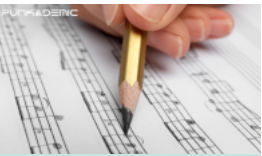
When most people think of a composer, they imagine someone sitting in a dusty attic with a grand piano, big white wig, and the year is 1800.
Here is a list of some of the topics we will cover:
- My background, and listen to some of my music
- What you need to know
- Myths of the composer
- Tools of the trade: Software
- Tools of the trade: Pencils and fine paper
- How do you start?
- The process
- Program music and metaphors
- Character sketches
- Writing through canon
- Form
- Starting with a plan
- Graphic form representations
- Film Music and Tension Cues
- Composing for Films and Games
- Any much, much, more!
01
Welcome & Overview
free
Lets get started by going over the main tools and concepts of this class.
Introduction
My Background
Why Tension and Release?
Review: Tools
Update! MuseScore 3.0
[DOWNLOAD] Staff Paper
Review: Process of Composing
02
Tension and Release in Form
Using form to create tension is a great high-level skill.
Long Term and Short Term
Forms That We Know So Far
Forms That Create Drama
Sonata Form
The 4 Elements of Sonata Form
Sonata Form Examples
Using Sonata Form for Tension and Release
[DOWNLOAD] Moonlight Sonata
Modern Uses of Form for Tension
Example: Muse (Butterflies and Hurricanes)
03
Tension and Release in Meter
Meter is a great way to play with the listener’s expectation.
Meter and Tension
Stylistic Concerns
Compound Meters
Compound Meter Definition
Compound Meter Signatures
Another Perspective
Rhythmic Patterns
04
Tension and Release in Rhythm
We take our discussion of meter a step further by focusing it on rhythm.
Rhythmic Patterns
Pattern Obfuscation
Example: Philip Glass (From the Soundtrack to The Truman Show)
[DOWNLOAD] Glass, Truman Sleeps
Example: Aporia
05
Tension and Release in Harmony
There are a number of techniques we use in our harmonic decisions to create tension and play with expectation.
Consonance and Dissonance
Prolonged Dominant
Emphasized Resolution
Pedal Tones
Long Resolution of Pedal Tones
Pedal Tones in Higher Voices
Example: Aphex Twin, Ventolin
06
Combining Techniques
We can always make one of these techniques stronger by combining it with another technique.
Using Multiple Techniques
[DOWNLOAD] Sonata in C, Mozart
Example: Kinesthesia, Movement 7
Film music and Tension Techniques
Composing Music for Films
07
Wrap Up
In this last section I would like to do a little wrap-up, and talk a little more about composing for film and television.
Coming Soon: Composition Techniques 3: Composing for Film
Thanks & Bye
But Wait! There’s More!
Certificate of Completion
Dr. J. Anthony Allen
Music PhD, Producer, Composer, Instructor, Professor, Author, & Ableton Certified Trainer.
ABOUT
Dr. Allen is a professional musician, top-rated online instructor, and university professor. In 2017 the Star Tribune featured him as a “Mover and a Shaker,” and he is recognized by the Grammy Foundation for his music education classes. He currently teaches at Augsburg University in Minneapolis, MN, Slam Academy, and Punkademic Courses.



![[Cubase工程模板] 我们让舞曲变得冷酷(374.33MB)](http://0daydown.top/wp-content/uploads/2025/01/1737177361589_副本.jpg)
![[Cubase混音工程] 全程Waves插件混完一首歌曲(332.21MB)](http://www.bixinyinyuan.com/wp-content/uploads/2025/01/1737176982830_副本.jpg)
![[Cubase工程60首] 编曲学习House/EDM/POP混音模版 MIDI文件(9.03GB+)](http://www.bixinyinyuan.com/wp-content/uploads/2025/01/1736476946100_副本.jpg)